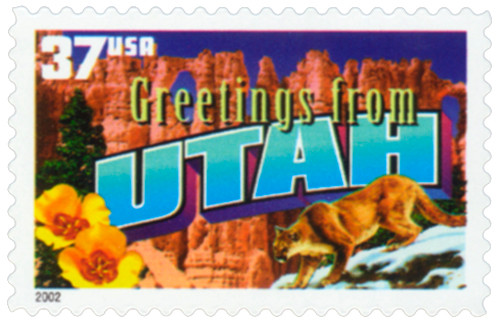
# 3710 - 2002 37c Greetings from America: Iowa
37¢ Greetings From America
Iowa
City: New York, NY
Quantity: 200,000,000
Printed By: American Packaging Corp. for Sennett Security Products
Printing Method: Photogravure
Perforations: Serpentine Die Cut 10.75
Color: Multicolored
On December 28, 1846, Iowa was admitted as our 29th state.
On June 17, 1673, two French explorers, Louis Jolliet and Father Jacques Marquette, became the first white people to arrive in Iowa. They traveled by canoe down the Wisconsin River to the Mississippi River, and landed on the Iowa side on June 25th.

In 1682, Robert Cavelier, Sieur de la Salle, reached the mouth of the Mississippi River. He claimed the entire region drained by the Mississippi for France. La Salle named the area Louisiana in honor of King Louis XIV. However, during the late 1600s to early 1700s, only a handful of missionaries, soldiers, and fur traders visited Iowa.
In 1762, France gave control of the portion of Louisiana west of the Mississippi to Spain. A French-Canadian, Julien Dubuque, received permission from the Fox Indians to mine lead in 1788, near the site of today’s Dubuque. Dubuque was Iowa’s first European settler, and he stayed there until his death in 1810. After Dubuque settled in Iowa, a small number of hunters and trappers also settled there.

In 1800, Spain returned control of western Louisiana to France. Then in 1803, France sold this vast territory to the United States with the Louisiana Purchase. From 1804–06, Meriwether Lewis and William Clark led the legendary Lewis and Clark Expedition through the area.

In 1812, Iowa became part of the Territory of Missouri when Louisiana became a state. During the early 1800s, fur companies set up trading posts on the Des Moines, Mississippi, and Missouri Rivers. Officially Indian land, Iowa was closed to settlers. When Missouri became a state in 1821, Iowa became part of an unorganized territory.
The U.S. government forced many Sauk and Fox Indians living in Illinois to move to Iowa. One leader, Chief Black Hawk, refused to move. In the Black Hawk War, fought in 1832, U.S. troops defeated Indian forces. After the war, the Indians lost additional territory in Iowa along the Mississippi River. White settlers quickly moved in. In 1834, the region was made part of the Territory of Michigan. Then in 1836, the Territory of Wisconsin was created.

On June 12, 1838, the land west of the Mississippi was separated from the Wisconsin Territory and organized as the Territory of Iowa. This land included all of Iowa, most of Minnesota, and two-thirds of North and South Dakota. Burlington served as the first capital until 1841, when it was moved to Iowa City.
Iowa’s territorial governor proposed statehood as early as 1839. However, Iowans opposed statehood, as that would require a tax to pay the salaries of local officials. In 1844, a constitutional convention was held, but disagreement over the state’s boundaries defeated statehood. In 1846, another convention was held, which adopted the state’s present boundaries.
37¢ Greetings From America
Iowa
City: New York, NY
Quantity: 200,000,000
Printed By: American Packaging Corp. for Sennett Security Products
Printing Method: Photogravure
Perforations: Serpentine Die Cut 10.75
Color: Multicolored
On December 28, 1846, Iowa was admitted as our 29th state.
On June 17, 1673, two French explorers, Louis Jolliet and Father Jacques Marquette, became the first white people to arrive in Iowa. They traveled by canoe down the Wisconsin River to the Mississippi River, and landed on the Iowa side on June 25th.

In 1682, Robert Cavelier, Sieur de la Salle, reached the mouth of the Mississippi River. He claimed the entire region drained by the Mississippi for France. La Salle named the area Louisiana in honor of King Louis XIV. However, during the late 1600s to early 1700s, only a handful of missionaries, soldiers, and fur traders visited Iowa.
In 1762, France gave control of the portion of Louisiana west of the Mississippi to Spain. A French-Canadian, Julien Dubuque, received permission from the Fox Indians to mine lead in 1788, near the site of today’s Dubuque. Dubuque was Iowa’s first European settler, and he stayed there until his death in 1810. After Dubuque settled in Iowa, a small number of hunters and trappers also settled there.

In 1800, Spain returned control of western Louisiana to France. Then in 1803, France sold this vast territory to the United States with the Louisiana Purchase. From 1804–06, Meriwether Lewis and William Clark led the legendary Lewis and Clark Expedition through the area.

In 1812, Iowa became part of the Territory of Missouri when Louisiana became a state. During the early 1800s, fur companies set up trading posts on the Des Moines, Mississippi, and Missouri Rivers. Officially Indian land, Iowa was closed to settlers. When Missouri became a state in 1821, Iowa became part of an unorganized territory.
The U.S. government forced many Sauk and Fox Indians living in Illinois to move to Iowa. One leader, Chief Black Hawk, refused to move. In the Black Hawk War, fought in 1832, U.S. troops defeated Indian forces. After the war, the Indians lost additional territory in Iowa along the Mississippi River. White settlers quickly moved in. In 1834, the region was made part of the Territory of Michigan. Then in 1836, the Territory of Wisconsin was created.

On June 12, 1838, the land west of the Mississippi was separated from the Wisconsin Territory and organized as the Territory of Iowa. This land included all of Iowa, most of Minnesota, and two-thirds of North and South Dakota. Burlington served as the first capital until 1841, when it was moved to Iowa City.
Iowa’s territorial governor proposed statehood as early as 1839. However, Iowans opposed statehood, as that would require a tax to pay the salaries of local officials. In 1844, a constitutional convention was held, but disagreement over the state’s boundaries defeated statehood. In 1846, another convention was held, which adopted the state’s present boundaries.
















